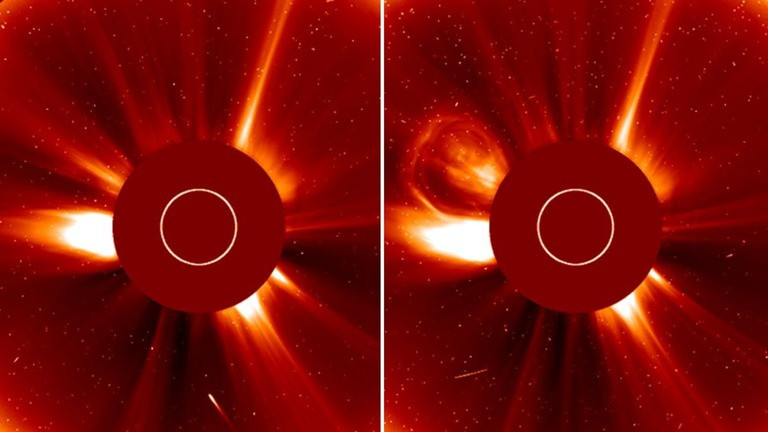「ハロウィーン彗星」最後の瞬間、NASA衛星が観測 太陽最接近生き延びられず
ハロウィーンの夜空を彩るはずだった彗星(すいせい)が、太陽に最接近して28日に崩壊しました
米航空宇宙局(NASA)の太陽観測衛星SOHOは、その最後の瞬間をとらえていました
C/2024 S1(アトラス彗星)は9月27日にハワイの観測所で発見され、10月末にかけて夜空に現れる可能性があったことから「ハロウィーン彗星」と呼ばれるようになりました
しかしNASAによると、氷とガスと塵でできた彗星は、太陽に最接近する近日点に近付くにつれて分解が始まり、28日に蒸発しました
C/2024 S1は太陽から約136万7942キロの距離を通過しました
太陽の至近距離を通過するこうした彗星はサングレーザーと呼ばれ、太陽の熱で蒸発してしまうことが多いです
「ハロウィーン彗星」最後の瞬間、NASA衛星が観測 太陽最接近生き延びられず

NASA satellite observes Comet Halloween’s final moments; it fails to survive its closest approach to the sun

NASA satellite observes Comet Halloween’s final moments; it fails to survive its closest approach to the sun
ハロウィーンの夜空を彩るはずだった彗星(すいせい)が、太陽に最接近して28日に崩壊しました

A comet that was supposed to brighten up the night sky on Halloween came closest to the sun and disintegrated on the 28th.

A comet that was supposed to brighten up the night sky on Halloween came closest to the sun and disintegrated on the 28th.
米航空宇宙局(NASA)の太陽観測衛星SOHOは、その最後の瞬間をとらえていました

NASA’s solar observation satellite SOHO captured the final moments.

NASA’s solar observation satellite SOHO captured the final moments.
C/2024 S1(アトラス彗星)は9月27日にハワイの観測所で発見され、10月末にかけて夜空に現れる可能性があったことから「ハロウィーン彗星」と呼ばれるようになりました

C/2024 S1 (Comet Atlas) was discovered at an observatory in Hawaii on September 27th, and came to be called the ”Halloween Comet” because it could appear in the night sky toward the end of October.

C/2024 S1 (Comet Atlas) was discovered at an observatory in Hawaii on September 27th, and came to be called the ”Halloween Comet” because it could appear in the night sky toward the end of October.
しかしNASAによると、氷とガスと塵でできた彗星は、太陽に最接近する近日点に近付くにつれて分解が始まり、28日に蒸発しました

But the comet, which is made of ice, gas and dust, began to break up as it approached perihelion, its closest approach to the sun, and evaporated on the 28th, according to NASA.

But the comet, which is made of ice, gas and dust, began to break up as it approached perihelion, its closest approach to the sun, and evaporated on the 28th, according to NASA.
C/2024 S1は太陽から約136万7942キロの距離を通過しました

C/2024 S1 passed at a distance of approximately 1,367,942 km from the sun

C/2024 S1 passed at a distance of approximately 1,367,942 km from the sun
太陽の至近距離を通過するこうした彗星はサングレーザーと呼ばれ、太陽の熱で蒸発してしまうことが多いです

These comets that pass very close to the sun are called sungrazers, and are often vaporized by the sun’s heat.

These comets that pass very close to the sun are called sungrazers, and are often vaporized by the sun’s heat.
